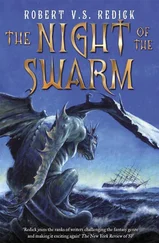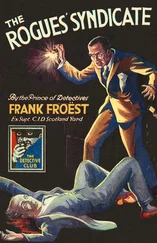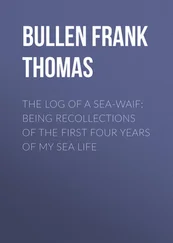From now on everything had to happen as quickly as possible. Bohrmann had asked for the ship to be slowed right down so that they could investigate a site he'd identified using data from the multi-beam echo-sounder and the video-sledge. Beneath the Sonne there was a large field of hydrates. Taking a sample meant releasing a monster that appeared to belong to the Jurassic age of deep-sea science. The video-guided grab – a pair of metal jaws weighing several tonnes – was scarcely the most sophisticated piece of technology. In fact, it was probably the crudest, yet most reliable way of wresting a chunk of history from the seabed. Opening its maw, it bit into the sediment, and tore out hundreds of kilos of silt, ice, fauna and stone, which it then deposited at the feet of the scientists. The sailors had named it T. Rex. As it dangled from the A-frame, jaws agape, ready to plunge into the sea, the similarity was striking. A monster in the service of science.
However, as with all monsters, the grab was powerful, but lumbering and dumb. Inside its jaws were floodlights and a camera, enabling its handlers to see where it was heading before they let it off the leash. That was impressive. But the dim-witted T. Rex was incapable of stealth. No matter how carefully you let it down – and there were limits, since it took force to penetrate the seabed – it created a bow wave that frightened away most creatures. As soon as their finely tuned senses detected it, worms, fish, crabs and any other organism capable of rapid movement escaped before it pounced. Even the more up-to-date instruments gave advance warning. The bitter words of a frustrated American scientist summed up the situation: 'There's plenty of life down there. The trouble is, it sees us coming and steps aside.'
The grab was lowered from the A-frame. Johanson wiped the rain off his face and entered the control room. A crewman was operating the joystick that moved the grab up and down. He'd spent the last few hours steering the video sledge, but he still seemed focused. He had to be: staring at hazy pictures of the seabed for hours on end had a hypnotic effect. A moment of carelessness, and a piece of equipment that cost as much as a brand new Ferrari would be lost forever.
Inside the control room the light had been dimmed. The monitors cast a pale glow on the watching faces of the people sitting and standing in front of them. The rest of the world no longer existed: there was only the seabed, whose surface they studied like a coded landscape in which every detail held a message.
Outside the cable slid over the winch.
The water looked as though it was going to spurt out from the monitors, then the metal jaws passed through a shower of plankton. The screens turned blue-green, then green, then black. Bright dots – tiny crabs, krill and other creatures – sped away like comets. Watching the voyage of the grab was like seeing the opening credits for the original Star Trek series, but now there was no music. It was deathly silent in the lab. The figures on the depth gauge were changing all the time. Then the seabed flashed into view, looking like a lunar landscape. The cable stopped.
'Minus seven hundred and fourteen metres,' said the man at the controls.
Bohrmann leaned over. 'Don't do anything yet.' The monitor filled with mussels. They liked to colonise hydrates, but now they were hidden by a mass of wriggling bodies. Johanson had a strange feeling that the worms weren't just burrowing in the ice but were eating the mussels in their shells. He could see jaws shooting out and ripping off chunks of mussel flesh, which vanished into the tube-like bodies. There was no sign of the white methane ice under the siege of worms, but they all knew it was there. Bubbles rose up from the bottom, with tiny shimmering fragments – splinters of hydrate.
'Now,' said Bohrmann.
The seabed rushed towards the screen. For a moment it looked as though the worms had risen to welcome the camera, then it went black. The iron jaws buried themselves in the methane and clamped shut.
'What the hell… ?' gasped the man at the controls.
The numbers on the panel were turning rapidly. They stopped briefly, then sped on.
'The grab's broken through. It's sinking.'
Hvistendahl pushed his way to the front. 'What's going on?'
'This can't be happening! There's no resistance!'
'Pull it up!' screamed Bohrmann. 'Quickly!'
The man jerked back the joystick. The counter stopped, and the numbers started to decrease. The grab rose upwards, jaws clenched. Its external cameras showed the vast hole that had opened. Swollen bubbles surged from inside it. Then a stream of gas gushed out, hitting the grab and engulfing it. Everything vanished in a seething whirlpool.
Greenland Sea
A few hundred kilometres north of the Sonne , Karen Weaver had just stopped counting. Fifty laps of the deck. She kept running up and down, careful not to get in the scientists' way. For once she was pleased that Lukas Bauer didn't have time to talk to her. She needed exercise, but the possibilities on board a research vessel were limited. She'd tried the gym, but the three exercise machines had driven her crazy so she was running instead. Up and down the deck – past Bauer's assistants, who were working on float number five, and past the crew, who were hard at work or standing in groups, watching her, suggestive comments on the tip of their tongues.
Puffs of white breath rose from her parted lips.
Up and down the deck.
She'd have to work on her stamina. It was her weak point. She made up for it in strength, though. Her body was like a sculpture: impressive muscles and glowing skin, with an intricately tattooed falcon between her shoulders. Yet Karen Weaver had none of the bulk of a female body-builder- in fact, she'd have made a perfect model, if only she had been a little taller and her shoulders less broad. A small, sinewy panther, she lived on adrenaline. Her favoured habitat was the edge of the abyss.
In this case, the drop was 3.5 kilometres. The Juno was sailing over the Greenland abyssal plain, an expanse of seabed beneath the Fram Strait, from which the cold Arctic water flowed south. The basin between Iceland, Greenland, the north Norwegian coast and Svalhard was one of the planet's two main water pumps. Bauer was interested in what was going on there – and so was Karen Weaver, on behalf of her readers.
Bauer beckoned for her to join him. With his bald head, huge glasses and pointed white beard, he resembled the cliché of an absent-minded professor more than any other scientist she'd met. He was sixty and already slightly hunched, but indefatigably energetic. Weaver respected people like Lukas Bauer. There was something almost superhuman about them. She admired them for their will.
'Take a look at this, Karen,' he called, in a clear voice. 'Incredible, isn't it? The water here is surging downwards at a rate of seventeen million cubic metres per second. Seventeen million!'' He beamed at her. 'That's twenty times the volume of all the rivers on Earth.'
'Dr Bauer.' Weaver placed a hand on his arm. That's the fourth time you've told me that.'
Bauer blinked. 'Really?'
'And you still haven't got round to explaining how the floats work. You're going to have to talk me through this, if you want me to do your PR.'
'Yes… Well, the floats – that is to say, the autonomous drifting profilers – they… Oh, but you know all that already, don't you? It's why you're here.'
'I'm here to make computer simulations of the currents, so people can see where the floats are going, remember?'
'Of course. Dear me, you can't possibly know… You don't even… Well, I'm a bit short of time, unfortunately. There's so much to do. Why don't you watch for a while and then-'
Читать дальше












